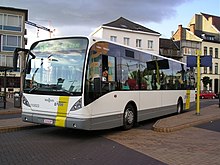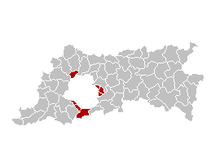Flemish Region
Flemish Region
Vlaams Gewest(Dutch) | |
|---|---|
| Anthem:De Vlaamse Leeuw ( "The Flemish Lion" ) | |
 | |
| Coordinates:51°00′N4°30′E/ 51.000°N 4.500°E | |
| Country | |
| Community | |
| Seat | City of Brussels(which is not part of the Flemish Region) |
| Government | |
| • Executive | Flemish Government |
| •Governing parties(2019) | N-VA,CD&V,Open Vld |
| •Minister-President | Jan Jambon(N–VA) |
| • Legislature | Flemish Parliament |
| •Speaker | Liesbeth Homans(N–VA) |
| Area | |
| • Total | 13,626 km2(5,261 sq mi) |
| Population (1 January 2024)[2] | |
| • Total | 6,821,770 |
| • Density | 500/km2(1,300/sq mi) |
| Demographics | |
| • Ethnic group | Flemings |
| • Languages |
|
| GDP | |
| • Total | €330.495 billion (2022) |
| ISO 3166 code | BE-VLG |
| Celebration Day | 11 July |
| Website | flanders.be |
TheFlemish Region(Dutch:Vlaams Gewest,pronounced[ˌvlaːmsxəˈʋɛst]),[5][a]usually simply referred to asFlanders(Dutch:Vlaanderen[ˈvlaːndərə(n)]),[b]is one of the threeregionsofBelgium—alongside theWalloon Regionand theBrussels-Capital Region.[6]Covering the northern portion of the country, the Flemish Region is primarilyDutch-speaking. With an area of 13,626 km2(5,261 sq mi), it accounts for only 45% of Belgium's territory, but 58% of its population. It is one of the most densely populated regions of Europe with around 500/km2(1,300/sq mi).
The Flemish Region is distinct from theFlemish Community:the latter encompasses both the inhabitants of the Flemish Region and the Dutch-speaking minority living in theBrussels-Capital Region.It borders theNetherlandsandFrance.
Politics
[edit]Immediately after its establishment in 1980, the region transferred all its constitutional competencies to theFlemish Community.Thus, the current Flemish authorities (Flemish ParliamentandFlemish Government) represent all theFlemish people,including those living in theBrussels-Capital Region.Hence, the Flemish Region is governed by the Flemish Community institutions. However, members of the Flemish Community parliament elected in the Brussels-Capital Region have no right to vote on Flemish regional affairs.
Administrative divisions
[edit]
The Flemish Region comprises fiveprovinces,each consisting ofadministrative arrondissementsthat, in turn, containmunicipalities(in total 300 municipalities in Flanders).
The seat of the Flemish parliament is located in Brussels, which is anenclavewithin – but not part of – the Flemish region, being specified that theBrussels-Capital Regionis established as an administrative region of Belgium in its own right. In contrast, the Walloon parliament has established its parliament in the territory ofWallonia,specifically in the city ofNamur,Namur Province.
| Province | Capital city | Administrative arrondissements |
Population (1 January 2020)[2] |
Area[1] | Population density | |
|---|---|---|---|---|---|---|
| 1 | Antwerp(Antwerpen) | Antwerp,Mechelen,Turnhout | 1,869,730 | 2,876 km2(1,110 sq mi) | 650/km2(1,700/sq mi) | |
| 2 | Hasselt | Hasselt,Maaseik,Tongeren | 877,370 | 2,427 km2(937 sq mi) | 360/km2(930/sq mi) | |
| 3 | Ghent(Gent) | Aalst,Dendermonde,Eeklo,Gent,Oudenaarde,Sint-Niklaas | 1,525,255 | 3,007 km2(1,161 sq mi) | 510/km2(1,300/sq mi) | |
| 4 | Leuven | Halle-Vilvoorde,Leuven | 1,155,843 | 2,118 km2(818 sq mi) | 550/km2(1,400/sq mi) | |
| 5 | Bruges(Brugge) | Bruges,Diksmuide,Ypres,Kortrijk,Ostend,Roeselare,Tielt,Veurne | 1,200,945 | 3,197 km2(1,234 sq mi) | 380/km2(980/sq mi) | |
| Flemish Region | 22 | 6,629,143 | 13,626 km2(5,261 sq mi) | 490/km2(1,300/sq mi) | ||
Economy
[edit]Flanders is home to a diversified modern economy, with emphasis put on research and development. Many enterprises work closely with local knowledge and research centres to develop new products and services.[7]TheGross domestic product(GDP) of the region was €270 billion in 2018, accounting for 59% of Belgium's economic output. GDP per capita adjusted for purchasing power was €36,300 or 136% of the EU27 average in the same year.[8]
Transport
[edit]
"De Lijn"serves as the main public transport company, run by the Flemish government. It consists of buses and trams.TECis the equivalent company in Wallonia, andMIVB-STIBin Brussels. The railway network run by theNMBS,however, is a federal responsibility.
The Flemish government is also responsible for about 500 kilometers of regional roads (Dutch:gewestwegen) and about 900 kilometers of highways in the territory of the Flemish Region. Other types of roads are provincial roads and municipal roads.
Demographics
[edit]Cities
[edit]Largest cities in the region include (with population figures as of 1 January 2018):[9]
- Antwerp(523,248)
- Ghent(260,341)
- Bruges(118,284)
- Leuven(101,396)
- Mechelen(86,304)
- Aalst(85,715)
- Hasselt(77,651)
- Sint-Niklaas(76,756)
- Kortrijk(76,265)
- Ostend(71,332)
- Genk(66,110)
- Roeselare(62,301)
TheFlemish Diamond(Dutch:Vlaamse Ruit) is the name of the central, populous area in Flanders and consists of several of these cities, such as Antwerp, Ghent, Leuven and Mechelen. Approximately 5.5 million people live in the area.
Language
[edit]The official language of the Flemish Region isDutch.[10]Thedialect clusterspoken in the region is sometimes colloquially referred to as Flemish (Vlaams),[11][12][13]Flemish Dutch (Vlaams-Nederlands), Belgian Dutch (Belgisch-Nederlands), or Southern Dutch (Zuid-Nederlands). Spelling and grammar are regulated by a single authority, theDutch Language Union(Nederlandse Taalunie), comprising a committee of ministers of the Flemish and Dutch governments, their advisory council of appointed experts, a controlling commission of 22 parliamentarians, and a secretariat.[14][15]The termFlemishcan be applied to the Dutch spoken in Flanders; it shows many regional and local variations.[16]The main dialect groups includeWest Flemish,East Flemish,BrabantianandLimburgish.

French (specificallyBelgian French) may also be used in the Flemish Region for certain administrative purposes in a limited number of the so-called "municipalities with language facilities"around the Brussels-Capital Region and on the border withWallonia.These "rim municipalities" around Brussels areDrogenbos,Kraainem,Linkebeek,Sint-Genesius-Rode,WemmelandWezembeek-Oppem.Brussels was originally a Dutch-speaking city (Brabantian dialect to be exact),[17]but it wasfrancisedin the 19th and 20th centuries and is now officially bilingual in French and Dutch[10](although largely French-speaking in practice).[18]Municipalities with language facilities on the border with Wallonia areBever(French:Biévène),Herstappe,Mesen(French:Messines),Ronse(French:Renaix),Spiere-Helkijn(French:Espierres-Helchin), andVoeren(French:Fourons).
Religion
[edit]Religion in the Flemish Region in 2016[19]
According to a 2016 survey by theFree University of Brussels,68% of Flemish citizens areRoman Catholic,2% areProtestant,26% are irreligious, while 2% have other religions.[19]
International relations
[edit]Twin regions and sister regions
[edit]See also
[edit]- Communities, regions and language areas of Belgium
- Count of Flanders
- De Vlaamse Leeuw
- Flanders
- Flemish
- Provinces of Belgium
References
[edit]Footnotes
[edit]Notes
[edit]- ^ab"Occupation du sol sur base du Registre cadastral, Belgique. Revenus en euro. Superficies en hectare. Superficie totale en pour mille"[Land use based on the cadastral register, Belgium. Income in euros. Areas in hectare. Total area in per thousand].Statistics Belgium(in French). 11 April 2020.Retrieved9 February2021.
- ^ab"On 1 January 2020, Belgium had 11,492,641 inhabitants".Statistics Belgium.26 May 2020.Retrieved9 February2021.
- ^"VGT: een erkende taal | Departement Cultuur, Jeugd & Media".vlaanderen.be(in Dutch).Retrieved7 June2024.
- ^"EU regions by GDP, Eurostat".ec.europa.eu.Retrieved18 September2023.
- ^In isolation,gewestis pronounced[ɣəˈʋɛst].
- ^The Belgian Constitution(PDF).Brussels, Belgium: Belgian House of Representatives. May 2014. p. 5. Archived fromthe original(PDF)on 10 August 2015.Retrieved10 September2015.
Article 3:Belgiumcomprises three Regions: the Flemish Region, the Walloon Region and the Brussels Region. Article 4: Belgium comprises four linguistic regions: the Dutch-speaking region, the French-speaking region, the bilingual region of Brussels-Capital and the German-speaking region.
- ^"Flanders | Flanders fits you".Flanders.be. Archived fromthe originalon 21 January 2012.Retrieved3 July2011.
- ^"Regional GDP per capita ranged from 30% to 263% of the EU average in 2018".Eurostat.
- ^"kek_demo".Aps.vlaanderen.be. Archived fromthe originalon 18 December 2009.Retrieved3 July2011.
- ^ab"La Constitution belge (Art. 4)"(in French). theBelgian Senate.May 2007.Retrieved18 January2009.
La Belgique comprend quatre régions linguistiques: la région de langue française, la région de langue néerlandaise, la région bilingue de Bruxelles-Capitale et la région de langue allemande.
. - ^"Flemish, Vlaams".BBC.14 October 2014.Retrieved26 November2016.
- ^De Cock, Barbara (2006),Flemish language policy in an era of globalisation(PDF),Gencat.cat,retrieved3 May2017
- ^"Flemish language, Alpha bet and pronunciation".Omniglot.Retrieved26 November2016.
- ^"De Taalunie – Wie zijn wij?"(in Dutch). Nederlandse Taalunie.Archivedfrom the original on 23 March 2011.Retrieved19 February2011.
- ^"De Taalunie – Werkwijze en beleid"(in Dutch). Nederlandse Taalunie.Archivedfrom the original on 18 March 2011.Retrieved17 February2011.
- ^Hoeksema, Jack."College 4 – 1830 Belgische onafhankelijkheid, Noord-Zuidverschillen, Dialecten en de rijksgrens, Frans-Vlaanderen"(in Dutch).University of Groningen(host site). Archived fromthe original(ppt)on 24 July 2011.Retrieved19 February2011.
- ^Backhaus, Peter (2007).Linguistic Landscapes: A Comparative Study of Urban Multilingualism in Tokyo.Multilingual Matters Ltd. p. 158.ISBN9781853599460.Retrieved26 March2013.
- ^Janssens, Rudi (2008).Taalgebruik in Brussel en de plaats van het Nederlands — Enkele recente bevindingen(PDF)(in Dutch) (Brussels Studies, nº13 ed.).Retrieved26 April2013.
- ^ab"Un sondage ORELA/IPSOS/Le Soir/RTBF:" Les Belges francophones et la religion ""(in French).Université libre de Bruxelles.Retrieved17 December2020.
- ^"ベルギー3 địa vực と “Hữu hảo giao lưu cập び lẫn nhau hiệp lực に quan する覚 thư” を ký kết ".Retrieved15 May2017.
External links
[edit]- (in English)Flemish authorities(Dutch:Vlaamse overheid).
- (in English)Flanders online(also in French, German and Dutch).
- Toerisme Vlaanderen
- (in French)French FlandersArchived19 February 2007 at theWayback Machine
- (in Dutch)Frans-Vlaanderen
- (in Dutch)The Flemish region reaches 6 million inhabitants




